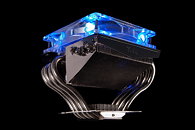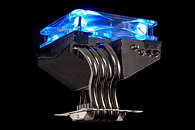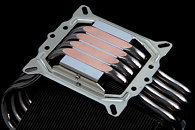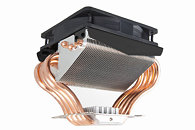Monday, September 28th 2009
Tuniq Intros Propeller 120 CPU Cooler
Tuniq introduced its newest CPU cooler, the Tuniq Propeller 120. This release follows the launch of the Tower 120 Extreme. Measuring 128(L) × 127.5(W) × 145(H) mm, and weighing at 590 g without the 120 mm fan, The cooler sports an unconventional design. From the CPU base pass four 8 mm nickel-plated copper heat-pipes that make direct contact with the CPU. The two ends of these heat-pipes pass through two blocks of aluminum fins. The fins are somewhat triangular in shape and are pitted for added surface area.
The bundled 120 mm MFDB fan comes with a fan-speed control knob, and spins at speeds between 1000~2000 rpm, pushing up to 90.65 CFM of air, with noise levels of 16~20 dBA ± 10%. The fan blows air onto the motherboard, passively cooling other components. The Propeller 120 also packs a tube of the company's newest Tuniq TX3 thermal compound. Supported sockets include LGA-1366, LGA-775, and AM3/AM2+/AM2. It comes in two variants, CR-PRO120-BK with black colored fins, and a blue LED-lit fan, and CR-PRO120-SV with normal (chrome) fins and an opaque black fan. The Propeller 120 should start selling this October.
The bundled 120 mm MFDB fan comes with a fan-speed control knob, and spins at speeds between 1000~2000 rpm, pushing up to 90.65 CFM of air, with noise levels of 16~20 dBA ± 10%. The fan blows air onto the motherboard, passively cooling other components. The Propeller 120 also packs a tube of the company's newest Tuniq TX3 thermal compound. Supported sockets include LGA-1366, LGA-775, and AM3/AM2+/AM2. It comes in two variants, CR-PRO120-BK with black colored fins, and a blue LED-lit fan, and CR-PRO120-SV with normal (chrome) fins and an opaque black fan. The Propeller 120 should start selling this October.




6 Comments on Tuniq Intros Propeller 120 CPU Cooler
Anyways, I have yet to see if HDT actually makes a difference. Megahalems and TRUE, and especially my own IFX-14 keep on proving otherwise.. :ohwell:
Just the distance alone from the heat pipes to the cooling fins is a disadvantage.
It has less metal (so less dissipation area) but should lower temps around the CPU socket.